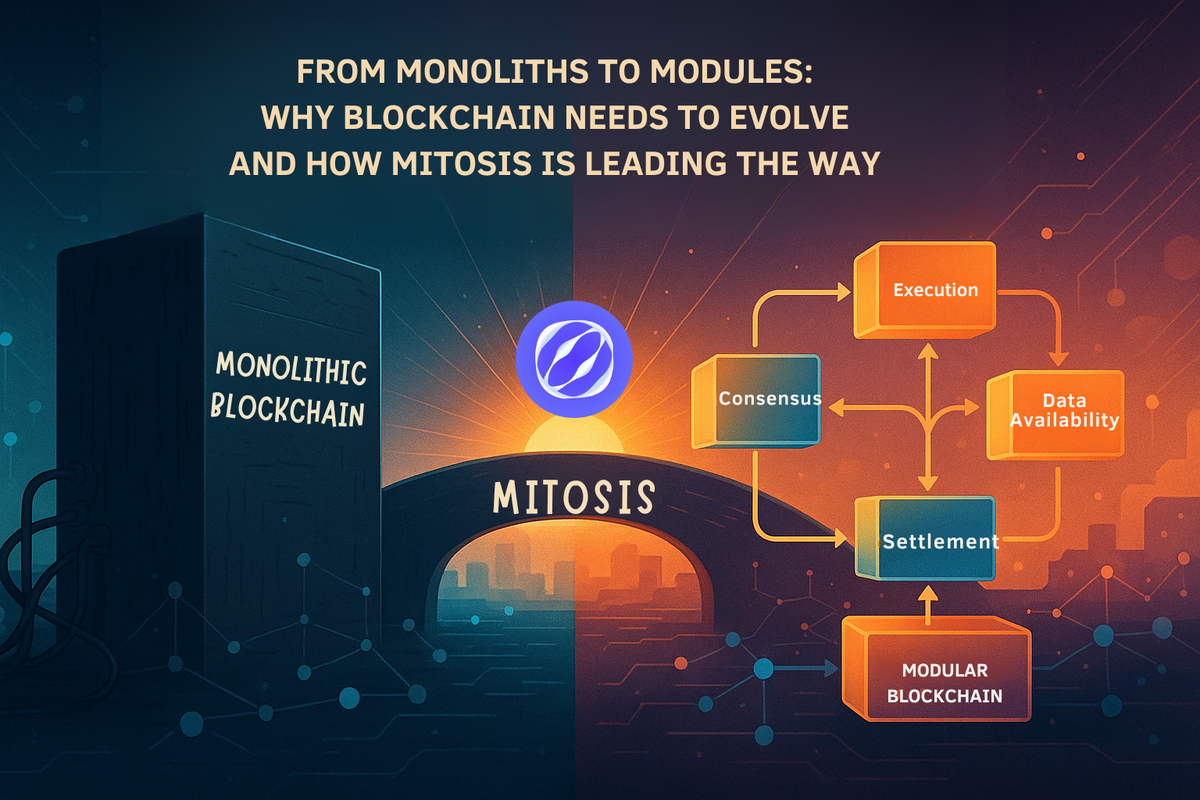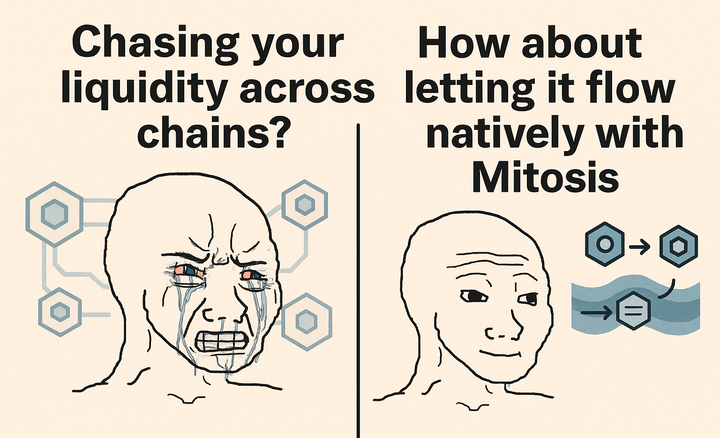From Monoliths to Modules: Why Blockchain Needs to Evolve and How Mitosis Is Leading the Way

- TL;DR:Blockchain is evolving along a similar trajectory as the internet, transitioning from bundled, monolithic platforms to a more flexible, specialized infrastructure. This shift towards modular blockchain architecture, where core components like execution, consensus, and data are separated, is crucial for improving scalability and composability. Mitosis is contributing to this evolution as a modular liquidity layer, addressing challenges in yield sustainability and cross-chain capital coordination. This next-generation infrastructure has the potential to drive significant advancement in Web3.
- The promise of blockchain to decentralize various systems is widely discussed.
- However, a key challenge remains: current performance, particularly in terms of scalability, is not keeping pace with this promise.
- The solution lies in a pattern observed in the internet's growth – the move away from closed platforms like AOL towards the open, modular web we use today.
- This architectural change is not merely a technical upgrade; it is essential for enabling broader adoption.
- It will facilitate the development of faster applications, larger ecosystems, and more seamless cross-chain interoperability.
🛠️ What Makes a Blockchain Tick
Every blockchain — whether it's Solana (monolithic) or Mitosis/Celestia (modular) — runs on a few core building blocks:

Consensus Layer: This layer is responsible for establishing agreement among nodes on the state of the blockchain, including the order and validity of transactions. It’s the foundational layer that ensures the network operates in a decentralized, trustless manner. Protocols like Proof of Stake (PoS) or Proof of Work (PoW) operate here.
Data Availability Layer: This layer ensures that all necessary data (e.g., transaction details) is accessible to nodes for validation and processing. This layer is critical in rollup-centric designs, where data availability solutions like Celestia’s modular approach ensure scalability.
Execution Layer handles the actual processing of transactions and smart contracts. This is where computations happen, such as executing a token transfer or running a decentralized app (dApp). In a rollup model, this layer often operates off-chain but relies on the layers below for security.
Settlement Layer:It finalizes transactions and resolves disputes, anchoring the entire system. In Ethereum’s roadmap, for example, the Settlement Layer is where rollups post their final state roots to the main chain for ultimate security and finality.
🏗️ Monolithic vs Modular: Why It Matters

Monolithic chains bundle everything together.
It's fast — until it's not.
- Imagine a single-lane highway at rush hour. It might flow smoothly at first, but as more cars (transactions, users, data) enter, everything grinds to a halt. This is what happens on monolithic chains. The initial UX is great—quick and cheap. But as usage grows, transactions become slow and expensive, frustrating users who face delays and high fees.
When you cram execution, consensus, and data into one box, you create bottlenecks.
- Think of a restaurant where the chef, waiter, and cashier all have to work in the same tiny space. They're constantly bumping into each other, slowing down service. Similarly, monolithic chains force all functions to compete for limited resources, leading to congestion. This translates to a poor UX: slow confirmation times, failed transactions, and unpredictable costs.
Everyone fights for the same bandwidth.
- Users end up in bidding wars for transaction inclusion, driving up gas fees. This creates an unfair and unpredictable UX, where only those willing to pay exorbitant amounts can reliably use the chain. Small users are priced out, hindering adoption.
Modular chains split the layers apart:
- This is like building separate lanes on the highway for cars, trucks, and buses. Each type of vehicle can travel efficiently without hindering others. In modular chains, execution, consensus, and data availability are handled by separate, specialized layers.
Each one can scale independently.
- If transaction volume increases dramatically, the execution layer can be scaled up without affecting consensus or data availability. This means the chain can handle more users and applications without sacrificing speed or cost-effectiveness, leading to a consistently good UX.
Each one can plug and play with others.
- Developers gain the freedom to choose the best execution layer for their application, whether it's optimized for speed, security, or specific features. This fosters innovation and allows for tailored UX, as applications can leverage the strengths of different modular components.
Less traffic jams. More freedom. Better apps.
- Modular chains pave the way for a smoother, more reliable, and more user-friendly blockchain experience. Users enjoy faster transactions, lower fees, and a wider range of applications tailored to their needs. This is crucial for mass adoption and bringing the benefits of Web3 to a broader audience.
🚀 Why Modularity Matters More Than Ever
Back in the day, AOL tried to be your entire internet experience — email, news, messaging, search, everything. This "walled garden" approach, where one company controlled all the services, limited innovation and user choice.
Today? We use a modular system:
- AWS for hosting: Amazon Web Services provides the fundamental infrastructure — the servers, storage, and computing power — that allows websites and applications to exist.
- Cloudflare for delivery: Cloudflare acts as a Content Delivery Network (CDN), speeding up websites by caching content closer to users, and also provides security services.
- Stripe for payments: Stripe specializes in handling online payment processing, making it easy for businesses to accept transactions.
Each service specializes in a specific function, allowing for greater efficiency and focus. Each service scales independently to meet the demands of a growing internet.
Blockchain is undergoing a similar transformation to overcome its inherent limitations, thanks to projects like:
- Celestia (modular data layer): Celestia focuses solely on providing a scalable and secure data availability layer, allowing other blockchains to outsource this function and improve their own scalability.
- Avail (data availability): Similar to Celestia, Avail is designed to be a data availability layer for other chains and applications, ensuring that transaction data is available and verifiable.
- Fuel (modular execution): Fuel focuses on being a modular execution layer, designed to achieve high transaction throughput.
- Mitosis (modular liquidity layer): Mitosis introduces modularity to liquidity, enabling more efficient transfer of assets between different blockchain networks.
- EigenLayer (re-staking infrastructure): EigenLayer introduces a new concept of restaking, allowing Ethereum's consensus layer to be used to secure other networks and services.
Specialize. Scale. Connect.
This shift towards modularity is essential for building scalable, interoperable, and user-friendly blockchain ecosystems.It's not just about technical efficiency; it's about creating a better user experience and fostering wider adoption of decentralized technologies. That’s how ecosystems win.
🧱 What It Means for Developers
Developers get more flexibility:
- No need to build full-stack infra from scratch
- Can plug into existing consensus or DA layers
- Choose execution environments optimized for their use case
It’s faster to ship. Easier to upgrade. Safer to scale.
⚠️ Modularity Isn't a Free Ride
Splitting blockchains into modules solves a lot — but creates new headaches:
- User friction: More moving parts = more chances for mistakes
- Security risks: Bridges can be weak spots
- Complex UX: Cross-chain apps are still clunky
The early internet had the same problem.
(Anyone remember "dial-up" days?)
We figured it out then — and we’ll figure it out again.
🌍 How Modularity Unlocks Blockchain’s Full Power
Imagine this future:
- 🎮 Gaming chains optimized for crazy-fast TPS
- 💰 DeFi chains armored with heavy security
- ⚡ AI chains trained for lightning-fast data
All separate.
All connected.
All cooperating.
Projects like Mitosis add another piece:
Liquidity modularity.
Mitosis turns liquidity into programmable capital: LPs can tokenize, allocate, and shift funds across chains efficiently. No lock-ins. No silos.
More apps. More innovation. Less gridlock.
⏳ When’s this all happening? Fast. Rollup adoption grew 400% between 2022–2023 alone (source: L2Beat). Expect modular stacks to be the norm by 2025 as demand for custom chains explodes.
🌍 How Modularity Unlocks Blockchain’s Full Power
Imagine this future:
- 🎮 Gaming chains optimized for crazy-fast TPS
- 💰 DeFi chains armored with heavy security
- ⚡ AI chains trained for lightning-fast data
All layers separate.
All connected.
All cooperating.
Projects like Mitosis add another piece:
Liquidity modularity.
Mitosis turns liquidity into programmable capital: LPs can tokenize, allocate, and shift funds across chains efficiently. No lock-ins. No silos.
With its Matrix and EOL frameworks, Mitosis creates a dual-track liquidity system:
- 🧠 EOL (Ecosystem-Owned Liquidity): Collective LP vaults governed by community voting. Yield is optimized and shared. It’s DeFi with coordination.
- 🧩 Matrix: Customizable campaigns where LPs choose where and how to allocate capital. Optional lockups, dynamic rewards, full control.
This means:
- Yield is earned based on participation, not just temporary incentives.
- LPs stay aligned with protocols, not just chasing short-term rewards.
- Liquidity becomes sticky, smart, and composable.
Mitosis isn’t just another DeFi protocol, it’s next-gen modular infrastructure built to anchor the liquidity layer of Web3. In the modular stack of tomorrow, Mitosis plays the role of the capital conductor: allocating liquidity efficiently across chains, syncing incentives, and helping protocols build long-term financial rails.
More apps. More innovation. Less gridlock.
⏳ When’s this all happening?
Fast. Rollup adoption grew 400% between 2022–2023 alone (source: L2Beat). Expect modular stacks — and modular liquidity infrastructure like Mitosis — to be the new standard by 2025.
📚 Lessons from the Internet: Modular Always Wins
Bitcoin and Ethereum started monolithic.
Because that’s how everything starts.
But just like AOL couldn’t hold the internet back forever, bundled blockchains won’t either.
Vitalik Buterin’s "Endgame" predicted it:
The future belongs to rollups, modular chains, sovereign execution environments.
Already, L2 adoption exploded 400% from 2022 to 2023 (source: L2Beat).
The trend is clear.
The modular era has begun.
What other modular infrastructure do you think will be developed in the nearest future?



Comments ()